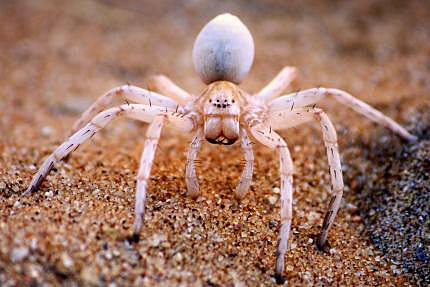We have much more to do and your continued support is needed now more than ever.
Spider-Man vs the Real Deal: Spider Powers

With Spider-Man: Into the Spider-Verse delighting audiences on the big screen, now is the perfect time to contemplate Peter Parker and . . . you know . . . spiders, a.k.a. arachnids (from the Greek word meaning get this creepy thing outta here; just kidding; it’s really derived from Arachne, a mythological Greek weaver who was turned into a spider).
The alter ego of Spider-Man, Peter Parker, became a superhero when he was bitten by an irradiated spider that injected radioactive chemicals into his body, giving him superhuman strength and agility, the ability to cling to most surfaces and thus run up walls, and a spider-sense that warns him of danger. You’ve probably been bitten by an irradiated spider yourself, so you know how it goes.
With that background, we get to today’s question: How do Spider-Man’s abilities stack up against those of a real spider?
Strength and Agility
Spider-Man is famed for his web-suspended swings from building to building over city streets. You can find examples of equally amazing leaps and bounds among real arachnids if you take a look at jumping spiders. In a single leap a jumping spider can cover as much as 50 times its own length. It does so by using a powerful internal muscle that blasts fluids from the body into the legs, flinging the spider through the air. If the current holder of the world record for the long jump, Norwegian Arne Tvervaag, could make a comparable leap, he’d cover about 300 feet from a standing start; instead his record, set in 1968, is 12 feet 2 inches.
Walking Up Walls
Thanks to a stick-to-almost-anything skin, Spider-Man can walk up walls. So can most spiders (if you’re a tarantula, do not try this at home—you’re too big and meant for burrowing). Each leg of a spider capable of climbing walls ends in a brushy covering of hair, and the end of each hair is in turn covered with microscopic organs that can take hold of small bumps in most surfaces, allowing the spider to go up walls and even across ceilings. This ability may be defeated (no pun intended; okay, it was intended) by very smooth surfaces, such as that of a bathroom sink.
Spider-Sense
Spider-Man is able to sense danger lurking near, the warning signal coming as a pain in his head that varies with the intensity of the threat. Spiders can detect danger coming their way with an early-warning system called eyes. You probably expected that. But that’s not all: their most important source of information about the world and its hazards comes from highly sensitive hairs that cover the bodies of most spiders. These hairs perceive even low-level vibrations coming through whatever surface a spider is standing on. Many species also bear hairs that sense vibrations in the air, including sound.
Webs
Spider-Man can fire strands of web from his wrists. Early in his career, he invented devices for doing this, but in later incarnations he developed biological adaptations that allowed him to make webs naturally. He can capture villains with the sticky stuff and use it like ropes for swinging from building to building.
Real spiders produce several types of webs—some that are not sticky but serve as a superstructure for webs, some that are sticky and capture prey, some used for wrapping up prey in neat little packages (which, in some species, are given as gifts by males to females while courting; whether Spider-Man has super gift-giving powers remains unrecorded). Some smaller spiders producer gossamer web, used as a sort of sail that catches the wind and can carry a spider far and wide, which probably explains in part why spiders are found almost everywhere in the world.
Spider silk comes from glands on the arachnid’s posterior, with different silks produced by different types of glands. Some silks are comparable in strength to high-grade alloy steel and can stretch up to four times their relaxed length without breaking. Made basically of protein and water, the silk is extremely lightweight once it dries. A single strand long enough to encircle the globe would weigh about 1 pound 2 ounces.
We’re Not Done Yet
Do you think spiders aren’t beautiful? Check a spectacular photo of a jumping spider and another of a famously venomous species. Or read about the “fastest spin on Earth”—the flattie spider!
Spiders and Kid Stuff
Check out our Ranger Rick Magazine‘s article on how to make candy spiders and for a spidery activity.
Help Wildlife in Your Home and Theirs
Spiders abound in nature and fit into the larger scheme of most ecosystems. Find out how you can help wildlife in your neighborhood.
National Wildlife Photo Contest
If taking wildlife photos is an enthusiasm of yours, whether in the far reaches of distant wilderness or in your own backyard, then submit your favorite images to National Wildlife’s Annual Photo Contest. The competition features some great prizes, including a $5,000 grand prize, and you can submit photos in seven categories, including one devoted just to backyard wildlife and natural gardening.
Like what you read? Please consider making a donation to support our work:
Donate!





















